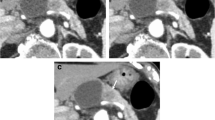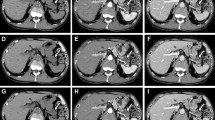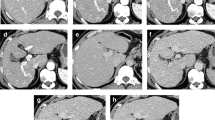Abstract
Purpose
To evaluate image quality, image noise, and conspicuity of pancreatic ductal adenocarcinoma (PDAC) in pancreatic low-dose computed tomography (LDCT) reconstructed using deep learning image reconstruction (DLIR) and compare with those of images reconstructed using hybrid iterative reconstruction (IR).
Methods
Our institutional review board approved this prospective study. Written informed consent was obtained from all patients. Twenty-eight consecutive patients with PDAC undergoing chemotherapy (14 men and 14 women; mean age, 68.4 years) underwent pancreatic LDCT for therapy evaluation. The LDCT images were reconstructed using 40% adaptive statistical iterative reconstruction-Veo (hybrid-IR) and DLIR at medium and high levels (DLIR-M and DLIR-H). The image noise, diagnostic acceptability, and conspicuity of PDAC were qualitatively assessed using a 5-point scale. CT numbers of the abdominal aorta, portal vein, pancreas, PDAC, background noise, signal-to-noise ratio (SNR) of the anatomical structures, and tumor-to-pancreas contrast-to-noise ratio (CNR) were calculated. Qualitative and quantitative parameters were compared between the hybrid-IR, DLIR-M, and DLIR-H images.
Results
CT dose-index volumes and dose-length product in pancreatic LDCT were 2.3 ± 1.0 mGy and 74.9 ± 37.0 mGy•cm, respectively. The image noise, diagnostic acceptability, and conspicuity of PDAC were significantly better in DLIR-H than those in hybrid-IR and DLIR-M (all P < 0.001). The background noise was significantly lower in the DLIR-H images (P < 0.001) and resulted in improved SNRs (P < 0.001) and CNR (P < 0.001) compared with those in the hybrid-IR and DLIR-M images.
Conclusion
DLIR significantly reduced image noise and improved image quality in pancreatic LDCT images compared with hybrid-IR.



Similar content being viewed by others
References
NCCN clinical practice guidelines in oncology: pancreatic adenocarcinoma, version 3. (2019) https://www.nccnorg/professionals/physician_gls/pdf/pancreaticpdf
Klauss M, Schobinger M, Wolf I et al (2009) Value of three-dimensional reconstructions in pancreatic carcinoma using multidetector CT: initial results. World J Gastroenterol 15:5827-5832
Recommendations of the International Commission on Radiological Protection. (1991) Ann ICRP 21:1-201
Kanal KM, Butler PF, Sengupta D, Bhargavan-Chatfield M, Coombs LP, Morin RL (2017) U.S. Diagnostic Reference Levels and Achievable Doses for 10 Adult CT Examinations. Radiology 284:120-133
Akagi M, Nakamura Y, Higaki T et al (2019) Deep learning reconstruction improves image quality of abdominal ultra-high-resolution CT. Eur Radiol 29:6163-6171
Singh R, Digumarthy SR, Muse VV et al (2020) Image Quality and Lesion Detection on Deep Learning Reconstruction and Iterative Reconstruction of Submillisievert Chest and Abdominal CT. AJR Am J Roentgenol 214:566-573
Jensen CT, Liu X, Tamm EP et al (2020) Image Quality Assessment of Abdominal CT by Use of New Deep Learning Image Reconstruction: Initial Experience. AJR Am J Roentgenol 215:50-57
Kim JH, Yoon HJ, Lee E, Kim I, Cha YK, Bak SH (2020) Validation of Deep-Learning Image Reconstruction for Low-Dose Chest Computed Tomography Scan: Emphasis on Image Quality and Noise. Korean J Radiol. https://doi.org/10.3348/kjr.2020.0116
Kolb M, Storz C, Kim JH et al (2019) Effect of a novel denoising technique on image quality and diagnostic accuracy in low-dose CT in patients with suspected appendicitis. Eur J Radiol 116:198-204
Shin YJ, Chang W, Ye JC et al (2020) Low-Dose Abdominal CT Using a Deep Learning-Based Denoising Algorithm: A Comparison with CT Reconstructed with Filtered Back Projection or Iterative Reconstruction Algorithm. Korean J Radiol 21:356-364
Han WK, Na JC, Park SY (2020) Low-dose CT angiography using ASiR-V for potential living renal donors: a prospective analysis of image quality and diagnostic accuracy. Eur Radiol 30:798-805
Brady SL, Trout AT, Somasundaram E, Anton CG, Li Y, Dillman JR (2020) Improving Image Quality and Reducing Radiation Dose for Pediatric CT by Using Deep Learning Reconstruction. Radiology. https://doi.org/10.1148/radiol.2020202317:202317
Noda Y, Kanematsu M, Goshima S et al (2014) Reduction of iodine load in CT imaging of pancreas acquired with low tube voltage and an adaptive statistical iterative reconstruction technique. J Comput Assist Tomogr 38:714-720
Noda Y, Goshima S, Kaga T et al (2020) Virtual monochromatic image at lower energy level for assessing pancreatic ductal adenocarcinoma in fast kV-switching dual-energy CT. Clin Radiol 75:320 e317-320 e323
Smith EA, Dillman JR, Goodsitt MM, Christodoulou EG, Keshavarzi N, Strouse PJ (2014) Model-based iterative reconstruction: effect on patient radiation dose and image quality in pediatric body CT. Radiology 270:526-534
Noda Y, Goshima S, Koyasu H et al (2017) Renovascular CT: comparison between adaptive statistical iterative reconstruction and model-based iterative reconstruction. Clin Radiol 72:901 e913-901 e919
Katsura M, Matsuda I, Akahane M et al (2012) Model-based iterative reconstruction technique for radiation dose reduction in chest CT: comparison with the adaptive statistical iterative reconstruction technique. Eur Radiol 22:1613-1623
Author information
Authors and Affiliations
Corresponding author
Ethics declarations
Conflict of interest
Authors of this manuscript declare no relevant conflicts of interest, and no relationships with any companies, whose products or services may be related to the subject matter of the article.
Additional information
Publisher's Note
Springer Nature remains neutral with regard to jurisdictional claims in published maps and institutional affiliations.
Rights and permissions
About this article
Cite this article
Noda, Y., Iritani, Y., Kawai, N. et al. Deep learning image reconstruction for pancreatic low-dose computed tomography: comparison with hybrid iterative reconstruction. Abdom Radiol 46, 4238–4244 (2021). https://doi.org/10.1007/s00261-021-03111-x
Received:
Revised:
Accepted:
Published:
Issue Date:
DOI: https://doi.org/10.1007/s00261-021-03111-x




